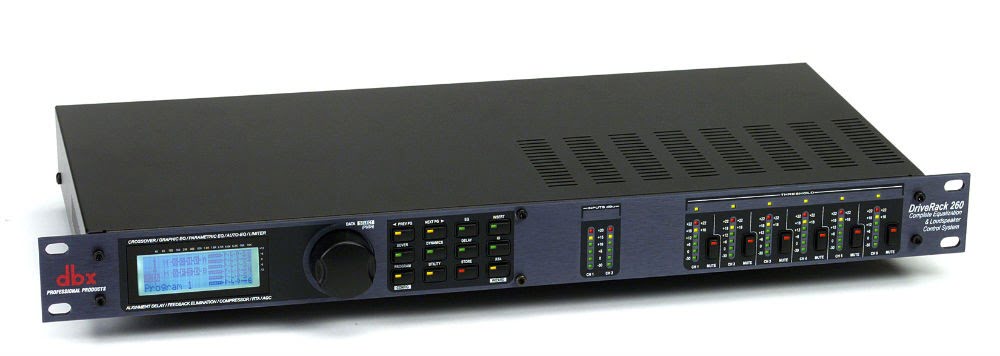

- DBX DRIVERACK 260 EQ AND SPEAKER CONTROL PROCESSOR MANUAL SERIAL
- DBX DRIVERACK 260 EQ AND SPEAKER CONTROL PROCESSOR MANUAL DRIVER
- DBX DRIVERACK 260 EQ AND SPEAKER CONTROL PROCESSOR MANUAL FULL
It has made these great speakers into even better ones. Believe me, this will keep you up way after your bedtime.īut it’s always about the sound, isn’t it? So here’s my summary of that: If it’s not clear by now that this a tweakers delight, then I’m not writing well enough. Well, with this baby, you can answer those burning questions and more, all in real-time. I mean, have you ever wondered what a Bessel 12 db/octave filter sounds like compared to a Butterworth 18? What would it sound like if I flip the polarity of the woofer? Or shift it’s output phase 22 degrees? Or add a 0.28 ms delay?
DBX DRIVERACK 260 EQ AND SPEAKER CONTROL PROCESSOR MANUAL SERIAL
The coolest thing has to be being able to sit at the listening position, RTA display at one’s side and a laptop on lap controlling the DriveRack via a serial cable and tweaking all those controls in real time and hearing (and seeing via RTA) the results. This thing offers an obscene amount of control available to the user. I do have to say that with an 8 band parametric on input and a four band parametric on each output channel (that’s six of those), I didn’t even touch half of the bands available to me. Then, using same stuff, determine EQ needs and adjust to taste.

Used these to figure the phase and polarity settings that best matched my speakers and their positioning in the room. Then pull out the weapons, my 30 band AudioControl RTA and the various test CD’s and DVD’s. A little volume balance tweaking and then listened to a song. Which sounds weird for a two-way speaker, but besides panel to woofer crossover, I also wanted to further split out the low ( XLR adapters on the inputs, since my Sunfire Amps have balanced inputs.įired up the system and hey, it works like a champ. So, how do I use this beast in my system?įirst, I wanted to have a three-way crossover for my Monoliths.
DBX DRIVERACK 260 EQ AND SPEAKER CONTROL PROCESSOR MANUAL FULL
Full control of settings and stored program via a PC application SubHarmonic synthesis (OK, a gimmick, but great on old recordings) Parametric EQ on inputs and per output (each band has its own PEQ) Compressor or limiters (if needed) to keep from overdriving a specific output Output adjustments for polarity and phase (in 1 degree increments!) Delays on any output channel, can delay the highs relative to lows O Mix-and-match, the LP can one filter type, while the HP can another

O Pick from types of filters: Butterworth, Bessel or Linkwitz-Riley O Pick from any slope from 6/db octave to 48/db O Pick from stereo 2 way or 3 way ( & many other, but not applicable here). Heck, since many ‘high-end’ units already have balanced interconnects, even that’s not the issue it might be.įor my application, several features of the DriveRack caught my attention: So other than the weird connectors, they tend to work fine in a home A/V setting. These units are built like tanks (have to survive roadies) and have really good specs (amplify a noisy x-over and the audience won’t like it). So what does a pro-gear unit have to do with an audiophile’s system? Well anything you care to do with it. Therefore it is chock-full of features designed to accommodate almost any combination of drive unit (low/mid/high) pairings and positioning in challenging acoustical environments. The premise behind the DriveRack 260 is to meet the demands sound professionals have for setting up and configuring ‘high-end’ speaker and amp rigs in different venues. Then I read up on the DBX DriveRack 260 speaker processor ( Man, the description light up my eyes and spun my propeller fast! However, I’m never satisfied with the status quo, therefore I kept an eye peeled for better units. For the money (around $300), it was a huge bargain in my book. The highs were a whole new dimension of clean. The critical low midrange and upper bass now merged better and the overall ‘tightness’ of the bass was improved. Using a pro-gear analog crossover, an Ashly XR2002, I got to see just what I had been missing. Secondly, I started playing around with active crossovers. But even after replacing those, I felt more could be had from this speaker. One was my ten year old woofers were beginning to go.
DBX DRIVERACK 260 EQ AND SPEAKER CONTROL PROCESSOR MANUAL DRIVER
In my case, I have a pair of Martin Logan Monolith IIIs with passive external crossovers that we’re just not giving me the best results with respect to panel and bass driver integration. If you like active’s, then the question becomes: which one? Replacing a speaker’s passive crossover with an active unit is generally considered to be a positive step. Review of the DBX DriveRack 260 speaker processor


 0 kommentar(er)
0 kommentar(er)
